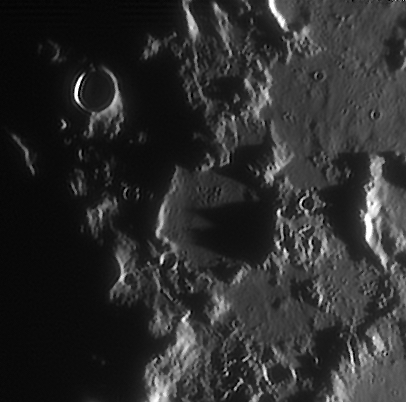› Forums › Variable Stars › chi Cygni 2015
- This topic has 11 replies, 5 voices, and was last updated 10 years, 3 months ago by
 Andy Wilson.
Andy Wilson.
-
AuthorPosts
-
8 July 2015 at 12:28 pm #573451
 Gary PoynerParticipant
Gary PoynerParticipantThe long period variable star chi Cygni has now returned to near naked eye brightness over the past week or so. Latest observations in the VSS database show this 408d period Mira star now at magnitude 6.0, with maximum brightness expected sometime in early to mid August. The 2014 maximum was one of the faintest on record at ~6.5, so we are now well past that level. It’s impossible to tell just how bright chi Cyg will get over the next few weeks, but it’s certainly worth following with a small pair of binoculars, digital camera or even the naked eye over the summer period. chi Cygni can get as bright as magnitude 3.
As the brightness changes quite slowly, one observation per week is sufficient at this time. Finder charts are available from the VSS web page.
Gary
16 July 2015 at 7:42 pm #576926 Gary PoynerParticipant
Gary PoynerParticipantchi Cyg was visible to the naked eye last night (July 15) at 4.6. Could be a bright maximum this year as we still have a way to go to it’s predicted date for maximum brightness.
Gary
24 July 2015 at 3:03 pm #576931 Mike HarlowSpectator
Mike HarlowSpectatorI thought it would be interesting to compare spectra of chi Cygni and mu cephei as they are both famous red stars.
I used the on loan BAA objective prism on my 12inch F/6.8 astrograph stopped to 4 inches and an un-modified Canon 550 DSLR. Despite the limited spectral range of the DSLR the spectra are clearly quite different. Comparison spectra are on the Orwell Astronomical Society forum:
http://forum.oasi.org.uk/download/file.php?id=393&mode=view
Only a quick look at this stage, I hope to get a CCD spectrum with the same set up in the next few weeks.
I also observed visually and chi Cygni was clearly visible to the naked eye. And through my 4 inch F/5 guide scope mu Cephei appeared to be redder than chi Cygni.
Mike.
25 July 2015 at 8:33 am #576932 Andy WilsonKeymaster
Andy WilsonKeymasterHi Mike,
Those are great looking spectra and an interesting comparison. Nice to see the BAA collection being put to good use.
If you fancy taking things to the next level then there is a wealth of free spectroscopy processing software now available. I’ve used BASS and ISIS, but there is also RSpec, Vspec and I think maybe a few others. These can produce a graph of a spectrum and help you to identify elements, along with various other functions.
I’m still a bit of a beginner in spectroscopy myself, starting out in September last year, but if you want pointers to any of the software then please let me know.
Do you know about the BAA spectroscopy workshop on 10th October at the Norman Lockyer observatory? It is being organised by the Variable Star Section noting it is more about an introduction to spectroscopy rather than variable stars.
Andy
25 July 2015 at 1:30 pm #576933 Mike HarlowSpectator
Mike HarlowSpectatorHi Andy,
Thanks for your comments. I’m learning Visual Spec as we speak! It’s good because it does the non-linear calibration of wavelength which is required when working with a prism.
Not sure I can make the Spectroscopy workshop in October…but hopefully there will be a DVD of the event…???
All the best, Mike
26 July 2015 at 7:02 pm #576936 Andy WilsonKeymaster
Andy WilsonKeymasterHi Mike,
It doesn’t look as though the spectroscopy meeting will be recorded. Hopefully the presentations will be made available after the event, as often happens.
Glad to hear you are already learning Visual Spec. Spectroscopy is a fascinating area that has really taken off in recent years. Variable stars make ideal targets for spectroscopy.
Best wishes,
Andy
16 August 2015 at 1:21 pm #576971 Andy WilsonKeymaster
Andy WilsonKeymasterHere is a low resolution spectrum I took of Chi Cygni last night, 15th August 2015.
I used Richard Walker’s spectroscopic atlas to identify the Titanium Oxide and Zirconium Oxide absorption bands, though TiO is most definitely dominant. I also picked out what I believe to be the first 4 emission lines in the hydrogen Balmer series. I understand the hydrogen emission lines are caused by a radiative and hypersonic shock wave propagating through the stellar atmosphere (http://arxiv.org/pdf/1109.6500v1.pdf). I was a little hesitant in the identification of H-alpha as I have not seen it in other online spectra, but I think this is correct.
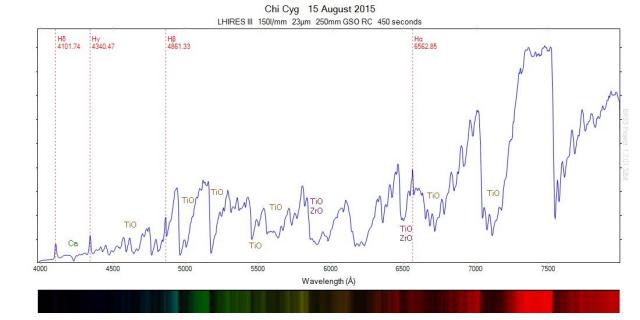
Best wishes,
Andy
17 August 2015 at 11:17 am #576975 john simpsonParticipant
john simpsonParticipantAndy,
Thanks for posting your spectral profile of Chi Cyg. RSpec and an SA200 recent purchases for me, still experimenting with set-up and working through the tutorials, but couldn’t resist having a look after Gary’s first post. Confidence booster to see similarities in the profiles even though mine just a single 20 sec. image with C6/collimator/SA200/DSLR wavelength calibrated only. Thanks.
john s
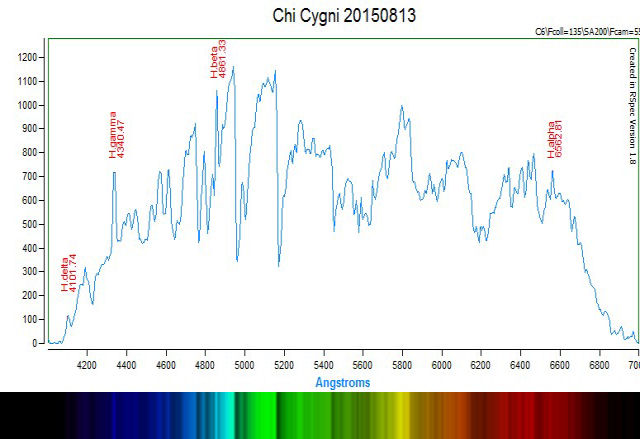 17 August 2015 at 6:20 pm #576976
17 August 2015 at 6:20 pm #576976 Andy WilsonKeymaster
Andy WilsonKeymasterJohn,
That is a really nice spectrum you have captured with the SA200. The 2 spectra match really well and I’m particularly interested to see you have the 4 first hydrogen Balmer emission lines. I’d be interested to see if this changes over the coming days and weeks.
I intend to switch to high resolution mode with my LHIRES III soon, so I may not be monitoring it at low resolution.
Best wishes,
Andy
25 August 2015 at 8:38 pm #576989 Steve CuthbertParticipant
Steve CuthbertParticipantHi guys
My last effort of Chi Cyg taken on my last clear night on the 17th July (yes 17th July ;-((()
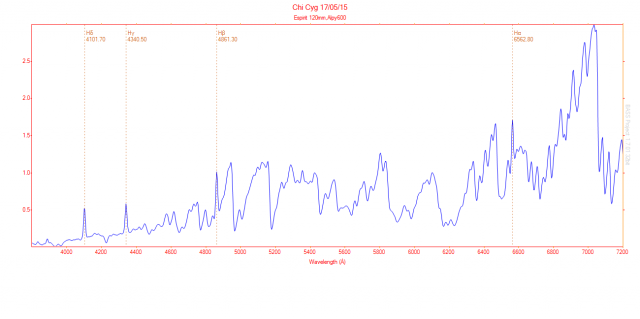
I too hope to attend the Spectro meeting in October!
regards
Steve
26 August 2015 at 8:15 pm #576992 Andy WilsonKeymaster
Andy WilsonKeymasterHi Steve,
Nice spectrum!
Interesting to see how Chi Cyg looked in July. It is a difficult to be sure with our different setups, but I wonder if there is a hint of the hydrogen emission lines weakening from July to August. Though this is obvious when comparing the spectra on the screen, I wonder if this might be an effect of different resolutions. We’d probably need to get an accurate measure of equivalent widths to be sure.
I’m looking forward to the October meeting.
Best wishes,
Andy
12 September 2015 at 3:03 pm #577036 Andy WilsonKeymaster
Andy WilsonKeymasterHere is a high resolution spectrum that I took of chi Cygni on 10th September, “zooming” in on the hydrogen alpha emission line. The spectrum shows wonderful complexity at this level of detail, though I can’t say that I’m able to interpret most of it. I suspect a lot is due to molecular absorption bands.
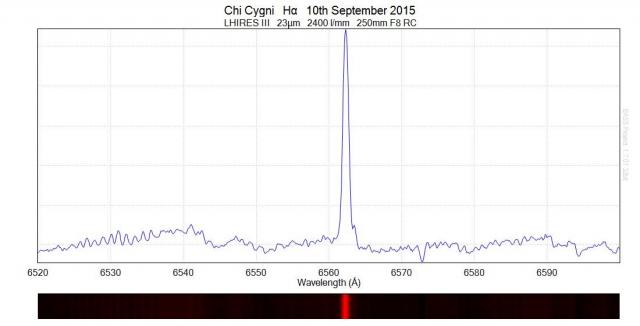
I have tried to identify the absorption line at about 6572 Angstroms but to no avail. Neutral Yttrium and singly ionised calcium have lines in that region, but they may not be the cause of this absorption line.
Best wishes,
Andy
-
AuthorPosts
- You must be logged in to reply to this topic.

